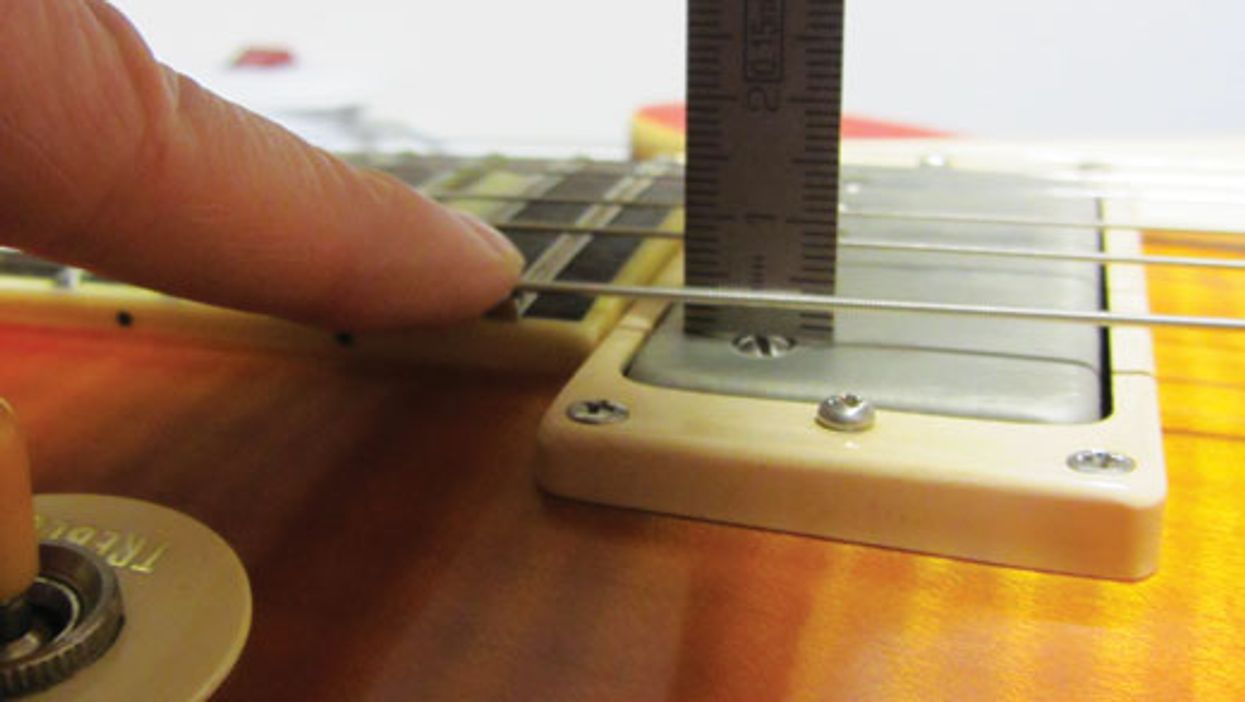I receive a lot of email about setting the correct height for humbucker pickups, so this month let's address that subject.
Humbuckers aren't simply big single-coils, so not all the usual single-coil setup rules apply. Generally speaking, you can move a humbucker a little closer to the strings without encountering the magnetic interference that can cause tuning problems and lack of sustain in single-coils.
Don't ditch those stock pickups yet!
Adjusting pickups is an important but often overlooked process—even some guitar companies pay little attention to it. Most guitars I see on the workbench have pickups that haven't been set up in any way, but it's exactly this process that can help address such player complaints as "It just doesn't sound right" and "There's something wrong with the pickups."
Most owners think they need replacement pickups, but it often turns out that proper adjustment makes them satisfied with their stock guitars. Yes, there are times when you should change pickups. (For example, if you want to shred, but your guitar has underwound PAFs.) But if you feel a certain something is missing in your tone, play around with the height adjustment screws before buying a new pickup set.
Adjusting pickups is an important but often overlooked process—even some guitar companies pay little attention to it.
Many players think their guitars come out of the box with perfectly adjusted pickup heights and fear changing the factory settings, so a goal of this column is to encourage you to grab a screwdriver and play around with the adjustment screws. After all, it's what they're for!
You don't need many tools—just a sharp pencil, masking tape, a small precision ruler, and an appropriate screwdriver. (Remember, flat screwdrivers aren't made for Phillips screws, and vice versa.) Before you start, apply some masking tape to both sides of the pickup covers. You can now mark the current pickup height with a sharp pencil. As long as you leave the tape on the cover, you can always return to the old adjustment in seconds, so you don't have to worry about recovering your old settings should you need to.
Height makes right. Tune your guitar and place it on a table or a workbench with a towel or blanket underneath.We measure pickup height from the top of the pickup to the bottom of the string while the string is pressed against the highest fret (Photo 1). It's a great help to use a capo on the top fret so you don't have to press the strings while adjusting the pickups, but this isn't possible on all guitars. Use a precision ruler.
The guys from Stewart-MacDonald have a special ruler for this called a String Action Gauge. This handy tool can measure not only pickup height, but also string height, saddle height, nut height, saddle slot depth, and more.

Image 2. Photo courtesy of singlecoil.com
The specs. If you do a web search on this topic, you'll find that everyone seems to recommend something different, so let's start with Gibson's official recommendations. In the 1950s Gibson recommended a distance of 1/16" (1.6 mm) for their PAFs in both neck and bridge position, and for both the bass and the treble sides of the pickup. Today Gibson recommends 1/16" (1.6 mm) for the bridge pickup and 3/32" (2.4 mm) for the neck. My own preference is to start with 3/32" (2.4 mm) on the bass side and 1/16" (1.6 mm) on the treble side for both bridge and neck humbuckers.
These specifications aren't set in stone—they're only starting points for your individual setup process, though there's a good chance this height will work for you right from the start. The perfect pickup height depends on your particular pickups, your strings, and, of course, personal taste. Some people like the sound of the pickups close to the strings, while others don't. If you have very powerful humbuckers, lower the pickup height a tad.
Next, adjust the height of the individual pole pieces so they mirror the radius of your fretboard, as shown in Photo 2.
After you've finished this process, play your guitar with your usual amp settings to get a first impression of the new tone. If the new setting works for you right from the start, excellent! If not, fine-tune by ear to taste, compensating for such culprits as a meddlesome G string that overpowers the adjacent strings, or a weak-sounding B string. Adjust the pole piece heights in small increments until it sounds right to you.
One final tip from my experience: On many guitars you'll suddenly hear a kind of "natural vibrato" once you dial in the sweet spot for the pickups. This can be a good indicator for you that you are done, or at least very close. See you next month. Until then, keep on modding!
[Updated 7/27/21]






































